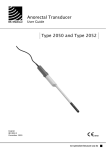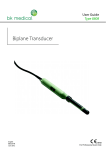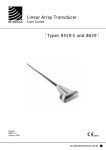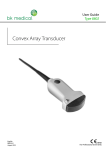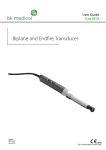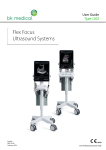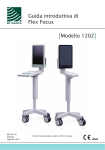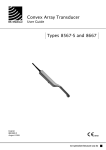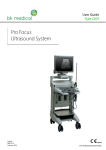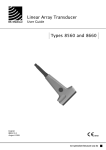Download BK Medical Type 8804 User guide
Transcript
Endosonic Probe User Guide Type 1850 English BB0096-M August 2006 WORLD HEADQUARTERS Mileparken 34 DK-2730 Herlev Denmark Tel.:+45 44528100 / Fax:+45 44528199 www.bkmed.com Email: [email protected] If you have comments about the user documentation, please write to us at the email address above. We would like to hear from you. BK Medical Customer Satisfaction Input from our customers helps us improve our products and services. As part of our customer satisfaction program, we contact a sample of our customers a few months after they receive their orders. If you receive an email message from us asking for your feedback, we hope you will be willing to answer some questions about your experience buying and using our products. Your opinions are important to us. You are of course always welcome to contact us via your BK Medical representative or by contacting us directly. © 2006 BK Medical Information in this document may be subject to change without notice. Endosonic Probe Type 1850 Introduction Scanning Plane General Information 1 1 2 Caring for the Transducer 2 Cleaning and Disinfection 2 Starting Scanning 3 Connecting the Transducer Using a Transducer Cover Using the Transducer Control Button Changing Orientation Assembling Type 1850 for Transurethral Use Assembling Type 1850 for Transrectal Use Single-Use Rectosigmoidoscope UA0681 3 3 3 3 4 4 7 Transurethral Scanning with Type 1850 8 Transrectal Scanning with Type 1850 9 Puncture Facilities 10 Mounting the Perineal Puncture Attachment UA0650 10 Performing Puncture and Biopsy 10 Transperineal Biopsy Cleaning after Puncture and Biopsy 11 12 3D Scanning with Type 1850 3D Scanning using Mover Support Pullback Mover UA0552 Variable Friction Support Arm UA0553 Assembly and Use of Mover Support Attaching the Fixation Clamp to the Examination Bed 12 12 13 13 13 14 Attaching the Fixation Clamp to the Support Arm Attaching the Instrument Clamp to the Support Arm Maneuvering the Support Arm Disposal 14 15 15 15 Endosonic Probe Type 1850 Endosonic Probe Type 1850 Introduction This is the user guide for Endosonic Probe Type 1850 and must be used together with Transducer Care, Cleaning & Safety which contains important safety information. 1850 is a mechanical (single-element) transducer for anorectal and transurethral examinations. Cable and Plug Cable Connection Transport Protection Cover Adaptor Thread Motor Housing Control Button Rectal Tube Rotating Rod Fixture for Rubber Sheath Rectal Transducer Urethral Transducer Perineal Puncture Attachment Transducer Mount Sealing Rings Rubber Sheath Hardcone Sheath Adaptor Fig. 1. Endosonic Probe Type 1850 with accessories FDA WARNING for the United States of America Type 1850 should not be used for fetal examinations. Scanning Plane The endosonic probe has three transducer attachments. See Fig. 2. for details. Fig. 2. Transducers for Type 1850 1 1850 • General Information General Information Product specifications for this transducer can be found in the Product Data sheet that accompanies this user guide. Acoustic output data and data about EMC (electromagnetic compatibility) for this transducer are on the Technical Data CD that accompanies this user guide. A full explanation of acoustic output is given in your scanner user guide. WARNING If at any time the scanner malfunctions, or the image is severely distorted or degraded, or you suspect in any way that the scanner is not functioning correctly: • Remove all transducers from contact with the patient. • Turn off the scanner. Unplug the scanner from the wall and make sure it cannot be used until it has been checked. • Do not remove the scanner cover. • Contact your B-K Medical representative or hospital technician. WARNING Always keep the exposure level (the acoustic output level and the exposure time) as low as possible. Caring for the Transducer The transducer may be damaged during use or processing, so it must be checked before use for cracks or irregularities in the surface. It should also be checked thoroughly once a month following the procedure in Transducer Care, Cleaning & Safety. Cleaning and Disinfection To ensure the best results when using B-K Medical equipment, it is important to maintain a strict regular cleaning routine. Full details of cleaning and disinfection procedures can be found in Transducer Care, Cleaning & Safety that accompanies this user guide. A list of disinfectants and disinfection methods that the transducer can withstand are listed in the Product Data sheet. Sterile covers are available. See the Product Data sheet for more details. WARNING Users of this equipment have an obligation and responsibility to provide the highest degree of infection control possible to patients, co-workers and themselves. To avoid cross contamination, follow all infection control policies for personnel and equipment established for your office, department or hospital. Caution Keep all plugs and sockets absolutely dry at all times. 2 1850 • Starting Scanning Starting Scanning All equipment must be cleaned and disinfected before use. Connecting the Transducer WARNING Keep all plugs and sockets absolutely dry at all times. Unscrew the connector plug cover on the transducer (if attached). On the connector plug, make sure that the red arrow is aligned with the red dot on the transducer socket. Pull back the outer locking mechanism and insert the plug in the socket. Release the locking mechanism to secure in place. When connected the transducer complies with Type B requirements of EN60601-1 (IEC 60601-1). Using a Transducer Cover The transducer should be enclosed in a transducer cover or a standard condom. See the Product Data sheet for a list of available transducer covers. Note: Sterile, disposable sheaths are recommended for intraoperative use. In the United States of America, it is recommended that probe sheaths have been market-cleared. In Canada, use only licensed probe sheaths. WARNING Because of reports of severe allergic reactions to medical devices containing latex (natural rubber), FDA is advising health-care professionals to identify their latex-sensitive patients and be prepared to treat allergic reactions promptly. Note: For Intraoperative Applications Apply sterile gel to the tip of the transducer or fill the cover with 1 to 2ml of sterile water. This improves the screen images by preventing image artifacts caused by air bubbles. Pull the transducer cover over the transducer. WARNING Use only water-soluble agents or gels. Petroleum or mineral oil-based materials may harm the cover material. Using the Transducer Control Button The transducer has a control button that you can press to Start or Stop scanning (freeze frame). Press the button for more than one second to make a copy of the image. Each time the button is pressed, a “beep” is emitted. Changing Orientation To change the orientation of the image on the monitor, refer to the applicable scanner user guide for instructions. 3 1850 • Starting Scanning Assembling Type 1850 for Transurethral Use Type 1850 can use a Storz 24Fr. resectoscope, which is shown in Fig. 3. The resectoscope is attached to the probe using the appropriate adaptor. Fig. 3. Storz 24Fr. resectoscope Slide the appropriate resectoscope adaptor over the probe’s rotating rod as shown in Fig. 4. Align the slot inside the adaptor with the small nodule on the probe. Push firmly into position and tighten by turning the adaptor’s ridged neck until it closes tightly against the probe’s handle. IP57 mark indicating watertight and image-direction Thread Nodule Fig. 4. Adaptor Lever Fitting Type 1850 with the resectoscope adaptor Select the urethral transducer, locate the small nodule on the transducer, align it with the slot at the end of the probe’s rotating rod and push the transducer firmly into place (see Fig. 5.). When correctly connected, the transducer and the rod will form a flat surface. Slot Fig. 5. Nodule Fitting Type 1850’s rotating rod with one of the transurethral transducers The 12 o’clock position on the displayed image will be in the direction of the midline between the P and the 5 (part of the IP57 watertight symbol) on the probe’s handle. The arrow shows the alignment position . IP57 The watertight symbol (IP57) should usually point in the ventral direction of the patient as shown in Fig. 4. Assembling Type 1850 for Transrectal Use To assemble the probe for transrectal scanning, remove the sealing rings from the appropriate rectal tube and slide it over the probe’s rotating rod (see Fig. 6.). Align the slot inside the 4 1850 • Starting Scanning threaded collar of the rectal tube with the nodule on the probe and push firmly into position. Turn the collar on the rectal tube until it closes tightly against the probe’s handle. WARNING It is essential for patient safety that the correct rectal tube is used together with the appropriate transducer head. Endosonic Probe Type 1850 Sealing Rings Rectal Tube Rectal Transducer Rubber Sheath UA 0799 Perineal Puncture Attachment Hard Cone Fig. 6. Type 1850 with accessories for transrectal scanning and perineal puncture Locate the nodule on the transducer. Align it with the slot at the end of the probe’s rotating rod and push the transducer firmly into position (see Fig. 5.). Check the transducer is secure by rotating it. When correctly connected, the transducer and the rod will form a flat surface. When the probe is assembled for transrectal scanning, check the rotation of the transducer and the probe’s rod before the rubber sheath is fitted. To start the rotation, press the builtin control button on the base of the probe’s handle. To stop rotation, press the button again. Fitting a Rubber Sheath Slide a rubber sheath (UA0799) over the transducer and, as far as possible, over the rectal tube (picture 1). Slide the sealing rings over the sheath (picture 2). 5 1850 • Starting Scanning Pull the rubber sheath out gently at the exposed end and screw the sealing rings tight to the rectal tube (picture 3). Fill the rubber sheath with approximately 50ml of degassed (lukewarm boiled) water through the valve on the rectal tube. Note: Do not use sterile water. Air bubbles may appear in the rubber sheath. As air bubbles will disrupt the path of the ultrasound beam and cause image artifacts, they must be removed. To remove all the air from the rubber sheath, hold the probe with the rubber sheath pointing downwards (see Fig. 7.) and draw off as much air as possible using the syringe. Refill the rubber sheath with degassed water. Repeat this procedure until there is no air left in either the sheath or the water outlet. Then draw all the water out of the rubber sheath. Fig. 7. Removal of air bubbles from the rectal tube and rubber sheath Fitting the Plastic Hood WA0543 or EA4020 Slide a plastic hood over the transducer and screw it reasonably tight to the rectal tube. 6 1850 • Starting Scanning Fill the plastic hood with approximately 10-20ml of degassed (lukewarm boiled) water through the valve on the rectal tube. Note: Do not use sterile water. Air bubbles may appear in the plastic hood. As air bubbles will disrupt the path of the ultrasound beam and cause image artifacts, they must be removed. To remove all the air from the plastic hood, hold the probe with the plastic hood pointing upwards and slowly inject more water using a syringe. Continue this procedure until there is no air left in either the plastic hood or the water outlet. Make sure that the 0.15mm air vent hole in the distal end of the plastic hood is not blocked. The 12 o’clock position on the displayed image will be in the direction of the midline between the P and the 5 (part of the IP57 watertight symbol) on the probe’s handle. The arrow shows the alignment position . IP57 The watertight symbol (IP57) should usually point in the ventral direction of the patient as shown in Fig. 4. EA4020 can be autoclaved or disinfected by immersion in a suitable solution. Do not exceed 20 cycles. WA0543 can be disinfected by immersion in a suitable solution. Single-Use Rectosigmoidoscope UA0681 The single-use rectosigmoidoscope UA0681 is designed to be used with Type 1850 to examine the rectum. Prepare the equipment as described earlier. See “Assembling Type 1850 for Transrectal Use” on page 4. The single-use rectosigmoidoscope, obturator and grip (UA0681) are ETO-sterilized in the package and ready to use. The reusable light source cable adaptor UA0682 is delivered nonsterile, but it can be sterilized in a steam autoclave. To use the light source cable adaptor UA0682, insert the closed end into the hollow handle of the black grip (Fig. 8.). Use the appropriate adaptor ring to connect a light cable. grip UA0682 Fig. 8. The single-use rectosigmoidoscope UA0681 7 1850 • Transurethral Scanning with Type 1850 The two small fins on the right of the black grip (Fig. 9.) are designed to anchor the rectosigmoidoscope to the transducer. fins Fig. 9. The black grip The numbers printed in italics on the rectosigmoidoscope tell you how far the image plane is from the anal verge (see Fig. 10.). Note that the actual end of the transducer is approximately 1cm deeper into the rectum. italics indicate distance to image plane Fig. 10. The rectosigmoidoscope Transurethral Scanning with Type 1850 All equipment must be cleaned and disinfected before use. WARNING Transurethral scanning with Type 1850 implies no greater risk of perforating the bladder wall than does normal cystoscopy. However, care must be taken to ensure that the bladder is not damaged by the tip of the transducer which protrudes 10 to 12mm in front of the origin of the ultrasound beam (i.e. in front of the scan center as seen on the screen). To check the rotation of the transducer and the probe’s rod, press the round button on the base of the probe’s handle. To stop rotation, press the button again. Note: There should be no rotation when the probe is being introduced into and removed from the patient. Prepare the patient in the usual way for ordinary cystoscopy. Perform an ordinary cystoscopy to ensure the urethra is clear and the resectoscope sheath is in the bladder. Insert the probe’s rotating rod into the resectoscope sheath. Fasten the sheath onto the probe by turning the adaptor lever clockwise to the lock position. See Fig. 4. 8 1850 • Transrectal Scanning with Type 1850 Ensure the bladder is kept well distended to avoid the transducer touching the wall. WARNING When scanning with the 1850, always ensure the transducer set-up on the monitor corresponds to the transducer head in use. If it does not, press the appropriate transducer select control on the console to change the set-up. If it is not possible to select the correct transducer from the menu, do NOT proceed with scanning and contact your local B-K Medical representative. To start scanning, press the probe’s built-in control button. Transrectal Scanning with Type 1850 Prepare the equipment as described earlier. See “Assembling Type 1850 for Transrectal Use” on page 4. All equipment must be cleaned and disinfected before use. To check the rotation of the transducer and the probe’s rod, press the round button on the base of the probe’s handle. To stop rotation, press the button again. Note: There should be no rotation when the probe is being introduced into and removed from the patient. The patient is examined in the left lateral decubitus, the lithotomy position or the prone position. A rectal palpation is made to ensure that the lumen of the rectum is clear. Lubricate the rectal tube and rubber sheath or hard cone with scanning gel or exploration cream. Cover the probe with an extra condom – this will ease cleaning later. Lubricate the outside of the condom with exploration gel and insert the probe in the usual way. Fill the rubber sheath with about 50ml of degassed water or the hard cone with 10 – 20ml of degassed water. WARNING Do not use excessive force during insertion. Do not make excessive lateral movements during or after insertion. Risk of injury or tissue damage to the patient could occur under certain circumstances. A digital palpation of the rectum may need to be carried out by a clinician prior to insertion or use of the probe as a precautionary measure. To start scanning, press the built-in control button at the base of the probe’s handle. Ensure that there is always water around the transducer. Check this on the displayed image. To complete the examination, scan the caudal region to make sure the anus has not ligated the passage. When you are sure the passage is free, press the button at the base of the probe’s handle to stop scanning. Ensure the probe has stopped rotating. Empty the water from the rubber sheath, if used, using a syringe and withdraw the probe. 9 1850 • Puncture Facilities Puncture Facilities Puncture and biopsy are possible with Type 1850. The puncture attachment is illustrated in the following pages with a brief description of its uses and operating instructions. For hygiene reasons, the transducer should be enclosed in a transducer cover or a standard condom. When sterile conditions are required, cover it with a sterile transducer cover. WARNING It is essential for the patient’s safety that only the correct puncture attachment is used with Type 1850. Never use unauthorized combinations of transducers and puncture attachments or other manufacturers’ puncture attachments. Mounting the Perineal Puncture Attachment UA0650 Loosen the thumb screw on the puncture attachment UA0650. Fit the puncture attachment on the rectal tube at a suitable position. Tighten the thumb screw. See Fig. 11. Fig. 11. Type 1850 assembled for transrectal scanning with puncture attachment UA0650 All parts of the puncture attachment can be autoclaved or disinfected by immersion in a suitable solution. Performing Puncture and Biopsy WARNING It is essential for the patient’s safety that only the correct puncture attachments, as described in this guide, are used. Never use unauthorized combinations of transducers and puncture attachments or other manufacturers puncture attachments. Before beginning a puncture or biopsy procedure, always check that the type number of the transducer and the type number or description of the puncture attachment match exactly those displayed on the scanner monitor. WARNING The row of puncture markers on the scan image is an indication of the expected needle path. However, the needle tip echo will not be seen before the tip actually is in the transaxial image plane. Cover the transducer with a sterile transducer cover. If the transducer cover is damaged when attaching the puncture attachment, replace it with a new cover. 10 1850 • Performing Puncture and Biopsy Note: Sterile, disposable sheaths are recommended for intraoperative use; and in the U.S.A. it is recommended that probe sheaths have been market-cleared. In Canada, use only licensed probe sheaths. See the Product Data sheet for a list of available transducer covers. Press the scanner Puncture or Biopsy control button to superimpose a row of puncture markers on the scan image. Move the transducer until the row of puncture markers transects the target. Insert the needle. The needle tip echo will be seen as a bright dot on the screen. WARNING If the needle guide is detached from the transducer during interventional procedures, cover the transducer with a new transducer cover. To remove the row of puncture markers from the scan image, refer to the applicable scanner user guide for instructions. WARNING Remember that the endosonic probe must have stopped rotating before you attempt to remove it. WARNING When performing a biopsy, always make sure that the needle is fully drawn back inside the needle guide before moving the probe. WARNING If rotation of the shaft is obstructed by pushing hard on the transducer head or the shaft, the image orientation may be disturbed (rotated). Do not perform punctures under these circumstances. There is no problem if the overload protection is activated and stops the rotation of the shaft. Correct image orientation can be secured by stopping and restarting the transducer. Transperineal Biopsy For transperineal biopsy, place the patient in either the lithotomy or the left lateral decubitus position. The perineum is prepared for puncture and anesthetized. Fit the perineal puncture attachment to the endosonic probe, insert the probe into the rectum. It is recommended that it is held fast on a fixation unit. Press the scanner’s Puncture control button to superimpose a row of puncture markers on the scan image. If there is more than one puncture guide available for the transducer, press the appropriate control button on the ultrasound scanner to select the required row of puncture markers. 11 1850 • 3D Scanning with Type 1850 Refer to the applicable scanner user guide for the method of changing which row of puncture markers appears on the monitor. Fig. 12. The principle for perineal puncture. The scanning plane within the body is shown Move the transducer until one of the puncture markers transects the target. Insert the needle. The needle tip echo will be seen as a bright dot on the screen once it transects the image plane. Take the biopsy in the usual way. If a fine needle is used, it may be helpful to use an additional needle guide. Cleaning after Puncture and Biopsy If biological materials are allowed to dry on the transducer or puncture attachments, disinfection and sterilization processes may not be effective. Therefore, you must clean puncture attachments and transducers immediately after use. Use a suitable brush to make sure that biological material and gel are removed from all needle guides and other channels and grooves. See Transducer Care, Cleaning & Safety for cleaning instructions. 3D Scanning with Type 1850 3D scanning with Type 1850 may be carried out in either of two ways: • Freehand – where Type 1850 is combined with the appropriate 3D scanner software. • Using mover support – where Type 1850 is combined with the appropriate 3D scanner software, the Pullback Mover UA0552 and the Variable Friction Arm UA0553. 3D Scanning using Mover Support 3D scanning with Type 1850 using Mover Support is carried out using: • The appropriate 3D scanner software. • The Pullback Mover UA0552. 12 1850 • 3D Scanning with Type 1850 • The Variable Friction Arm UA0553. Fig. 13. Type 1850 and Pullback Mover UA0552 mounted on Variable Friction Arm UA0553 Pullback Mover UA0552 Further information about the Pullback Mover UA0552 can be found in the user guide. Variable Friction Support Arm UA0553 Maintenance Periodically check that all screws on the Variable Friction Support Arm UA0553 are securely fastened and that all joints are adequately lubricated with standard lubricant oils or grease to ensure their continued performance. Contact your B-K Medical representative if you believe the correct functioning of the Variable Friction Support Arm is impaired in any way. Caution: The Variable Friction Support Arm must not be immersed or autoclaved. Assembly and Use of Mover Support The Pullback Mover UA0552 is mounted on the examination bed using the Variable Friction Support Arm UA0553. Fig. 14. Variable Friction Support Arm UA0553 The Variable Friction Support Arm UA0553 (see Fig. 14.) consists of: • A Support Arm (A); • Two identical fixation clamps (B and C); 13 1850 • 3D Scanning with Type 1850 • A variable friction wheel (D). One of the two fixation clamps (B or C) is used to secure the support arm to the examination table (the support clamp) with the other fixation clamp being used to secure the Pullback Mover to the Support Arm (the instrument clamp). The Support Arm can be manipulated so that the Pullback Mover is optimally positioned with respect to the patient. It can also be locked into position, thus preventing accidental movement of the setup. UA0553 fits onto the rail along the side of the examination bed or onto the bed itself. UA0553 should be positioned so that the Pullback Mover will easily reach the patient. Fig. 15. Fixation Clamp Attaching the Fixation Clamp to the Examination Bed The fixation clamp is shown in Fig. 15. Turning the handle (E) in a clockwise direction tightens the jaws of the clamp to match the dimensions of the mounting rail or of the operating table itself. Attaching the Fixation Clamp to the Support Arm The clamp has a hand-screw (F) and a security pin (G) on the upper jaw, which control the attachment of the Support Arm. At each end of the support arm are universal ball joint brackets (H), which rotate 360o (see Fig. 16.). To attach the bracket to the support clamp: • Loosen the hand-screw (F) by turning counterclockwise • Insert the distal end of the bracket into the socket on the top of the support clamp while depressing the security pin (G). To remove, reverse the procedure. Fig. 16. Universal Ball Joint Bracket at the end of the Support Arm With the joint inserted into the socket on the support clamp, the arm is secured by tightening the handscrew (F) in a clockwise direction. 14 1850 • Disposal Attaching the Instrument Clamp to the Support Arm The clamp has a hand-screw (F) and a security pin (G) on the upper jaw, which control the attachment of the Support Arm (see Fig. 15.). At each end of the support arm are universal ball joint brackets (H), which rotate 360o (see Fig. 16.). The joint is attached to the support clamp by loosening the hand-screw (F) by turning counterclockwise and inserting the distal end of joint into the socket on the top of the support clamp while depressing the security pin (G). To remove, reverse the procedure. Maneuvering the Support Arm The support arm has a universal ball joint midway along its shaft. The Variable Friction Wheel (D) is used to fix the precise position and the setting of the arm. Tightening the wheel by turning in a clockwise direction secures the settings of all of the universal ball joints in the arm – in the mid-point and at both ends. The setup can now be moved over into the patient area. Caution: All hand wheels and screws should be locked before any interventional procedure, thus preventing accidental movement of the setup. Disposal When the transducer is scrapped at the end of its life, national rules for the relevant material in each individual land must be followed. Within the EU, when you discard the transducer, you must send it to appropriate facilities for recovery and recycling. See the applicable scanner user guide for further details. WARNING For contaminated disposals such as transducer covers or needle guides, follow disposal control policies established for your office, department or hospital. 15 1850 • Disposal 16




















